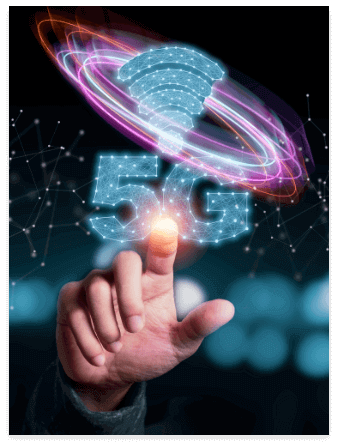As the demand for connection grows, especially with 70% of the U.S. workforce relying on wireless devices, businesses are faced with the challenge of adapting to this digital shift within the next four years. The prevalence of wireless devices is rapidly increasing, and with technologies like Private 5G/LTE, the potential for maximizing their usefulness is unprecedented. Only organizations equipped to leverage these advancements will reap the benefits, leaving others trailing behind.

To ensure your readiness for the impending shift, it is crucial to seamlessly integrate Private 5G/LTE into your existing network. This strategic integration not only ensures that your organization's wireless requirements are met today but also future-proofs them through our cutting-edge enterprise solutions. Embracing a comprehensive approach, supporting a spectrum of networks including Private 5G/LTE, and DAS, is the key to achieving widespread wireless coverage and enhancing business continuity. This positions organizations to thrive in the era of heightened connectivity dependence.
A growing number of forward-thinking CIOs are turning to Black Box for expert guidance in seamlessly incorporating these new technologies into their established wireless networks. This proactive approach positions your organization to harness the full potential of these advancements, meeting the escalating demands placed on wireless networks.
Discover the Power of Private 5G/LTE in Your Environment: Contact us now to schedule a no-obligation test drive and witness firsthand how Private 5G/LTE can elevate the performance of your devices within your unique ecosystem.
With 5G and OnGo™, coupled with other wireless networks, it is important to create a strategy that supports everything wireless—both existing and new.
Black Box can help enterprises implement their wireless strategy
and plan for tomorrow, today by following these principles.
Start by learning the wireless requirements for the devices and applications you use now and plan to use in the future. Design a wireless network to meet those needs. This outside-in approach means that your network will be ready for anything.
With 5G and Private LTE, together with purpose-built wireless networks, you have more leverage now than before. Place the right device and application on the right network to expand your organization’s overall wireless capacity.
When using the two previous principles, you can leverage coverage, capacity, and network selectivity to provide mission-critical performance. Not only on one network, but across all networks.
Mission-critical performance is built into everything we do—from design to deployment to support.
Today’s wireless technologies give organizations many opportunities to streamline their operations and improve the customer experience. Black Box can help you create a complete network that takes full advantage of these advanced technologies with our business WiFi solutions to meet your organization’s unique needs. Come and discover the power of 5G & OnGo.
Use the increased speed of 5G wireless technology to increase your enterprise’s efficiency while reducing costs.
Learn MoreBuild customizable and secure Private LTE wireless networks to increase indoor coverage and capacity. Put OnGo to the test on-site with these demos.
Healthcare Test DrivePublic safety DAS and enhanced, in-building two-way radio services are an absolute necessity for first responders.
Learn MoreUse a real-time locating system to manage assets, optimize workflow efficiencies, and maximize visitor satisfaction.
Learn More
Over the last decade, wireless has become crucial to everything we do. Wireless is not slowing down, but accelerating at an ever-increasing rate. At the heart of wireless technology is 5G and the increased bandwidth for faster connectivity and greater productivity.
Today, 5G technology support nearly 1.3 billion connections. This will more than double to 4.8 billion by the end of 2026. The rapid growth in 5G devices requires organizations to be ready for the new technology or be left behind.
Find out what you need to do now to prepare for 5G in this white paper.
Get the White PaperWhat can 5G and OnGo™ do for your organization? Learn from our 5G and OnGo™ experts how to maximize mobile connectivity.
Navigating the 5G Paradigm Shift: Black Box’s Strategic Expertise for Corporate Readiness
Download FlyerTransforming Manufacturing: Unleashing the Power of Private LTE/5G Networks with Black Box
Download Flyer5G is the fifth generation of cellular wireless/mobile technology. First there was 1G that was built from nothing — a clean sheet of paper. Every subsequent generation (2G, 3G, and 4G) has been incrementally built on top of the preceding generation and offers increased capacity and speed. 5G will continue this evolution but promises to make large scale improvements. Specifically, 5G promises to deliver 1) speeds in excess of 1 Gbps up to ten times faster than 4G, 2) ultra-low latency <1 mSec, and 3) effective IoT to a massive number of devices.
There are two frequency bands that 5G networks can operate on: sub-6 GHz and above 30 GHz millimeter waves (mmWave). 4G networks use frequencies below 6 GHz.
The higher frequencies above 30 GHz can carry a lot of data very quickly and are better for use in high-density, high-traffic areas such as airports, convention centers, and stadiums. Millimeter wave networks are limited in range (often less than a square mile) and data is easily blocked by trees and buildings. So to accommodate users in high-density areas, many, many small antennae have to be installed for direct line-of-sight service. The smaller 5G antennas provide precise directional control where as 4G towers send data in all directions.
Low-band frequencies, such as the sub-6 GHz range, can provide 5G service in lower density areas and high density areas that don’t have direct line-of-sight to a 5G mmW cell.
4G isn’t going away and there will be no hard cut over. 4G and 5G will coexist. For instance, if your device drops a 5G signal, it will fall back on 4G LTE.
It’s estimated that 80% of all wireless traffic originates indoors so 5G service will be critical to IoT applications such as smart retail, healthcare, hospitality, finance, as well as enterprise communications.
The first release of 5G, in late 2017 by the 3rd Generation Partnership Project (3GPP), was for non-standalone 5G New Radio (5G NR). 5G NR is a set of standards that replace the LTE network 4G wireless communications standard. An important goal of 5G NR is to support the growth of wireless communication by enhancing electromagnetic radiation spectrum efficiency.
2020 should see 5G make a more meaningful impact on consumers and enterprises. There are some 5G devices and smartphones available now. It’s expected that there will be up to 20 new 5G devices by the end of 2020, including smartphones, driven by the Apple iPhone 12.
There are a number of reasons including the high-cost to implement the 5G mmW network, and the acquisition of local regulatory approvals for construction of the dense antenna sites. It’s estimated that telecom companies will invest as much as $275 billion into 5G infrastructure before 2025.
No. LTE growth will continue. Since many bands currently used for 3G and LTE will be reallocated to 5G over the coming years, building a strong RF path today will ensure a solid 5G foundation tomorrow.
5GE is not 5G. It stands for 5G Evolution and it’s the name for AT&T’s existing 4G LTE Advanced service.
5G can help businesses increase efficiency while reducing costs particularly as IoT fuels innovations in retail, hospitality, manufacturing, finance, healthcare, transportation, public safety, and other applications. Business leaders should budget for 5G equipment and plan for more automation, artificial intelligence, machine learning, and big data analytics.
5G is on track to become the fastest-adopted mobile communication technology in history. By 2026, it will become the global wireless standard, leaving older 4G networks behind.* Now is the time to create your wireless network of the future. As your partner, we’ll work with you to find the right wireless solution for your organization from one of our best-in-breed partners.
While some integrators can help you with one or two of your wireless networking needs, Black Box can help you with all of them (Wi-Fi, DAS, RTLS, etc.). Our dedicated team of solution architects and deployment engineers will help you make sense of 5G and OnGo™ and understand whether one or both of these new technologies would be a good addition to your existing system. We can then help you develop a comprehensive plan that addresses your current needs while preparing you for the future.
Know More
Leave a commentOrder by
Newest on top Oldest on top